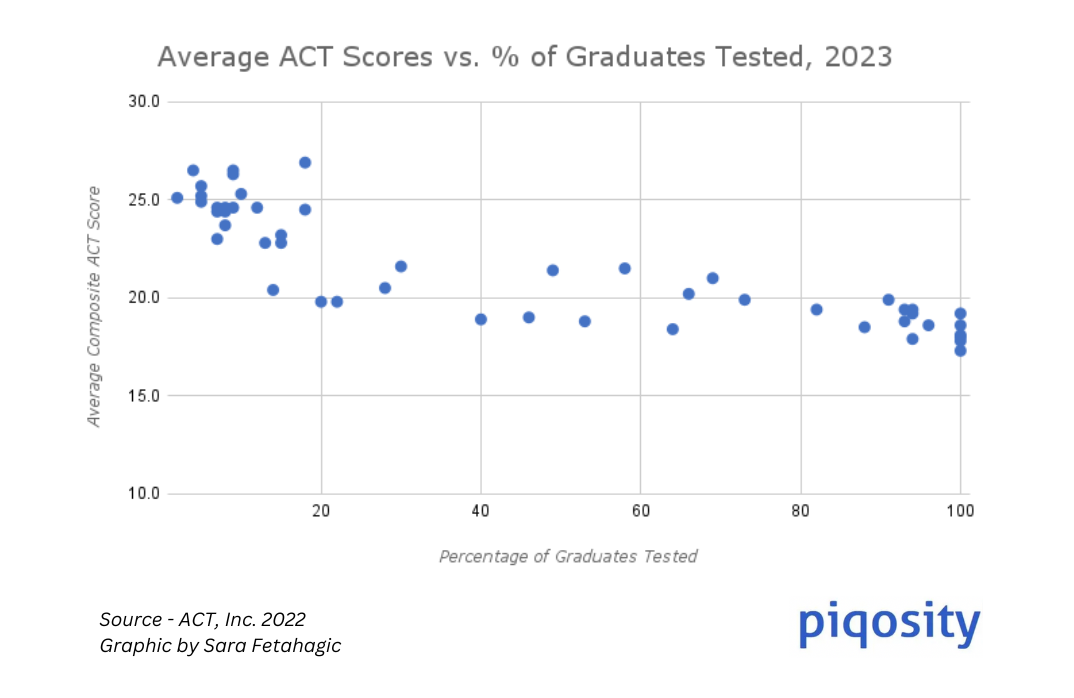
In the 2022 graduating class, 62,024 Wisconsin students took the ACT; their mean composite score was a 19.4 out of a possible 36. For comparison, 2021’s graduating class had about 1,800 more students test and scored slightly higher, with a mean composite of 20. Nationally, the average composite score was a 19.8 (down from 2021’s mean composite of 20.3).
(Top image caption – Kettle Moraine High School of Health Sciences in Wales, WI (just outside of Milwaukee) had the highest average 2022 ACT scores.)
ACT scores can be an effective indicator of student college- and career-readiness, and the best high schools are those which adequately prepare their students for college or a career. As such, if you’re wondering which are the top high schools in Wisconsin, then it’s a good idea to look at the ones with the best ACT scores! This article looks at general trends in Wisconsin’s most recently published ACT scores from 2022 with a focus on the top high schools across the state.
Wisconsin Scores in Context
Since 2016, Wisconsin has administered the ACT to all its high school juniors; this means that the state’s data over the last several years is remarkably complete. In 2022, it tested 93% of students—one of 14 states where over 90% of graduates took the ACT. Among these, Wisconsin tied with Nebraska for the second-highest average composite score. (Utah ranked highest with an average of 19.9.)
In general, states with higher testing levels tend to have lower average scores. This is shown in the graph below, which plots the average scores of all 50 states (and the District of Columbia) against the percentage of graduates who were tested.

Although the data is not perfectly linear (real-life data rarely is), there is a clear correlation between higher levels of testing and lower average scores. One main reason for this is that they include results from students whose future plans may not include college-level coursework. (In some cases, these students will “take” the test but not actually complete it, resulting in artificially low scores).
In states where standardized testing like the ACT is optional, most test-takers are self-selecting and academically advanced, which is reflected in their test scores. For example, consider Washington D.C. and Massachusetts, which had the highest average ACT scores in the nation (26.9, 26.5), but only tested 18% and 9% of graduates, respectively. With this context, Wisconsin’s high ranking among states with over 90% participation is particularly impressive.
ACT College Readiness Benchmarks
The ACT’s “College Readiness Benchmarks” are the scores (out of 36) on the subject area tests that indicate a student’s chances of college success. The ACT believes that meeting the benchmarks for English, Reading, Mathematics, and Science gives a student a 50% chance of earning a B or higher or a 75% chance of getting a C or higher in a corresponding freshman-level college course. Unchanged since 2013, these benchmark scores and their college course equivalents are:
- English (English Composition) – 18
- Reading (Social Sciences) – 22
- Math (College Algebra) – 22
- Science (Biology) – 23
Since 2015, the ACT has also offered a College Readiness Benchmark for coursework in STEM (science, technology, engineering, and math), based on scores on the Math & Science subject area tests. Because college-level STEM coursework tends to be more academically challenging (for instance, many STEM freshmen begin with Calculus instead of Algebra), ACT has determined that the benchmark ACT score is significantly higher for STEM than in other subject areas. Meeting the STEM benchmark indicates a 50% chance of earning a B or higher in identified college-level STEM courses. The benchmark score is:
- Math & Science (STEM) – 26
More than Half of Wisconsin Juniors are Not College–Ready

Above: Percent of Wisconsin students (teal) compared to the nation (blue) meeting ACT College Readiness Benchmarks (ACT Inc.)
With an average ACT composite score of 19.4, Wisconsin’s Class of 2022 slightly trails the national average for students meeting ACT College Readiness Benchmarks (CRBs) in two subject areas. Nearly a majority of Wisconsin students (49%) are prepared for college English, the only subject area in which more than forty percent of students met the benchmark score. Only 37% met the Reading benchmark. Although a minority of graduates are college-ready in Math (31%) and Science (32%), these numbers are on par with national averages.
Concerningly, when compared to the class of 2019, this set of graduates showed less college preparedness in all areas. The biggest drop over the last few years is in Math, in which 8% fewer students met the readiness benchmark. The number of students meeting 0 CRBs has been on the rise, and the amount of students meeting three or more benchmarks and the number meeting 3+ has been falling nationwide—the chart below illustrates this trend for Wisconsin’s ACT test-takers.

Wisconsin ACT Scores Show a Racial Achievement Gap
Sadly, one of the biggest indicators of ACT success is one over which students have no control: their racial background. Nationally, Asian Americans have the highest rates of success, followed by white students. Students who identify as Black or African American score the lowest, just behind students with American Indian heritage. (Students who identify as either Hispanic or Pacific Islander score somewhere in the middle.)
Wisconsin’s 2022 results mirror these nationwide disparities. While 37% of white students and 35% of Asian students met three or more College Readiness Benchmarks, only 6% of Black students and 14% of Latino students did the same. The performance of Wisconsin’s Black students has been particularly concerning; they are meeting CRBs at half of the national average for Black students.
Although the achievement gap between Black and white students has narrowed in the past several years, this is largely due to white students performing more poorly on the ACT, rather than a marked improvement in Black students’ scores. Wisconsin has a long way to go to when it comes to fostering equitable educational opportunities and improving outcomes for students of color, particularly Black students.
It’s important to note that this disparity in scores is not unique to the ACT. A report from the National Assessment of Educational Progress (NAEP) studied 4th- and 8th-grade students indicated that Wisconsin has the widest educational achievement gap in the nation. Disparities in ACT scores likely have their roots in disparate early childhood educational experiences.
How to Improve ACT Scores
Luckily for students looking to increase their chances of ACT success, there are several actions they can take which are statistically likely to improve their scores.
- Focus on schoolwork and take academically challenging classes. Students who do better in school nearly always do better overall on standardized tests like the ACT. Students hoping to improve their chances on the ACT should aim to take “core curriculum” courses (four years of English and three years of math, social studies and science).
- Take the ACT more than once. There is a clear statistical advantage to retesting; in 2022, the average composite score of Wisconsin students who took the ACT two or more times was 23.8, over 5 points higher than the average composite score (18.5) of those who took the test only once. Students worried about the cost of retesting should consider ACT’s fee waiver program, which allows eligible students to test for free.
- Spend time studying and preparing specifically for the ACT. Taking practice tests helps students familiarize themselves with the content and the format of the test and gives them specific feedback. In addition, working with a tutor can be an effective way of improving a student’s weakest areas and developing test-taking strategies. Piqosity offers a full suite of free ACT Practice materials and analyses of previously-released ACT tests, perfect for students looking to increase their chances of ACT success.
Most Popular Wisconsin Colleges for ACT Examinees
More than 82% of Wisconsin’s Class of 2022 didn’t leave a response when asked about their post-High School plans on the ACT test form. Most of the remaining students, however, indicated that they aspire to pursue a four-year bachelor’s degree. As expected, the vast majority of these college-bound students (plus many of those who left no response on the previous query) aim to stay within the borders of the Badger State!
The top five colleges among Spring 2021 test-takers were:
- University of Wisconsin – Madison
- University of Wisconsin – La Crosse
- University of Wisconsin – Milwaukee
- University of Wisconsin – Eau Claire
- University of Wisconsin – Oshkosh
Admission to some of these schools is fairly competitive—at Madison (although submitting ACT scores is optional) an ACT score of 28 or above is recommended for applicants. At Oshkosh, the recommendation is more easily attainable: an ACT score of 21 or higher.
These colleges are also within the financial reach of many: all five rank within the Top 15 Most Affordable Colleges in Wisconsin, with yearly in-state tuition below $10,000.
Best High Schools in Wisconsin by ACT Scores
Several of the best Wisconsin high schools tied when it came to the highest ACT scores, with a total of eighteen surpassing an average score of 23. The table below presents 2022 ACT Scores from the just over 500 Wisconsin high schools for which full data was available. Explore the original data at the Wisconsin Department of Public Instruction.
Top 10 Wisconsin High Schools by 2022 Average ACT Scores (composite)
- High School of Health Sciences (24.9)
- Brookfield Central High & Cedarburg High (23.9)
- Waukesha Engineering Preparatory Academy & West High (23.8)
- Tesla Engineering Charter School (23.7)
- Shorewood High (23.6)
- Renaissance School, South Shore Jr/Sr High, & Whitefish Bay High (23.4)
- Brookfield East High, Eisenhower Middle/High, & Lakeview Technology Academy (23.3)
- Arrowhead High (23.2)
- Kettle Moraine Global School (23.1)
- Homestead High, Laurel High, and Middleton High (23.0)
How to Read This Sortable Table
- The default sort is by composite score from highest to lowest; to change the sorting order, click on the header by which you want to sort
- “Avg Score” is the composite ACT score from 0 to 36
- “English,” “Reading,” “Math,” and “Science” refers to the school’s average scores in each subject test from 0 to 36
- “# Tested” is the number of students who sat for the exam at each school
You are trying to load a table of an unknown type. Probably you did not activate the addon which is required to use this table type.
Get Prepared for the ACT with Piqosity
If you’re a student preparing for the ACT and looking for ways to improve your test readiness, Piqosity is here to help! Piqosity is a simple, all-in-one learning platform for students who want to score better on their ACT in less time. Our tools monitor your progress to tell you exactly what you need to practice to reach your desired score.
We offer a full suite of ACT test prep materials: 12 full-length ACT practice tests, over 70 distinct concept lessons, personalized practice software, and much more.
The best part? You can try out all of Piqosity’s features with our free community account. When you’re ready to upgrade, Piqosity’s year-long accounts start at only $89. Plus, get a 10% off coupon just by signing up for our mailing list!
For the full datasets referenced in this article:
- The Condition of College and Career Readiness 2019: Wisconsin Key Findings, ACT, Inc.
- U.S. High School Class of 2022 Graduating Class Data, ACT, Inc.
- Wisconsin ACT Results 2021-22, Wisconsin Department of Public Instruction
More Educational Resources from Piqosity:


